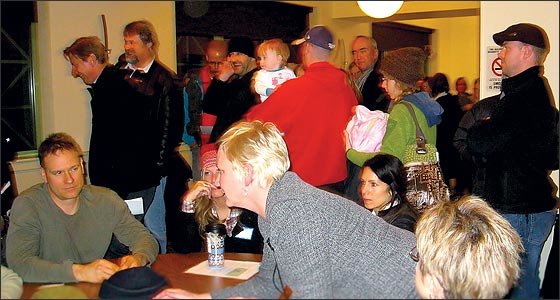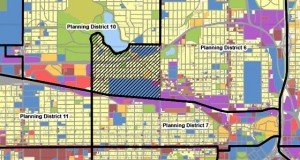 The organizers ran out of name tags at the Jan. 9 public meeting to discuss possible changes to District boundaries 6 and 10. The gathering attracted about 170 people, exceeding expectations and demonstrating how important an issue this appears to be to residents. (Photo by Jan Willms)
The organizers ran out of name tags at the Jan. 9 public meeting to discuss possible changes to District boundaries 6 and 10. The gathering attracted about 170 people, exceeding expectations and demonstrating how important an issue this appears to be to residents. (Photo by Jan Willms)By JAN WILLMS
The organizers ran out of name tags at the Jan. 9 public meeting to discuss possible changes to District boundaries 6 and 10. The gathering attracted about 170 people, exceeding expectations and demonstrating how important an issue this appears to be to residents.
The District Councils were established in 1975 as a citywide citizen participation process, according to the City of Saint Paul. There are currently 17 of them, based on neighborhoods and not on population.
“Various groups of South Como residents have attempted to be redistricted into the Como Park (District 10) planning council over the past 20 years,” said Amy Brendmoen, Ward 5 councilmember.
South Como lies west of Dale Street, south of Maryland Avenue and Lake Como, east of Lexington Avenue and north of the BNSF Railroad, and it is part of Planning District 6.
Brendmoen said she has heard the request for a boundary change from an overwhelming majority of South Como constituents who have contacted her office, although a few have expressed opposition to the change.
Those numbers seemed to be reflected at the public meeting, as one resident after another spoke up for changing the boundaries. The meeting, hosted by the City’s Department of Planning and Economic Development (PED) in cooperation with District 10 and District 6, was set up to hear public concerns.
Both District Councils have voted against making the boundary changes. Kim Moon, a District 10 board member, read a letter sent by the district to Brendmoen’s office.
“While we are concerned about how we will adequately serve 30% more constituents without additional City funds, of greater importance to us are the following reasons for our opposition to the proposed boundary change.
“The Council has heard limited opposition from the community to the current boundaries and does not feel there is a clear and defined reason or need for changes. This appears to us to be a top-down proposal being imposed on district councils, rather than a genuine grassroots effort.”
“In our opinion, the proposal limits citizen participation and seems counter-productive to the mission of promoting broad-based community input. The current boundaries offer a broader and more diverse perspective, allowing residents from across District 10 and District 6 to influence decisions affecting Como Regional Park.”
”The proposal shifts the focus of District 10’s activities away from representing all residents towards becoming a venue primarily for those concerned by the park. Residents, for whom the park is not a sole issue, will be further marginalized.”
“We currently enjoy a positive working relationship with the District 6 Planning Council, and support them,” Moon concluded.
He was followed by one resident after another citing their reasons for wanting a district boundary change.
“My daily life is more impacted by Como Park than by Rice Street,” one District 6 resident said.
“The swimming pool is across from my house,” claimed Art Oglesby. “Como Park has a huge influence. District 10 addresses dozens of issues related to the park, and District 6 does not address those issues.”
“I can smell Como Park and live close enough I can throw a baseball and hit its fields, but people on Maryland Avenue have more control over the area,” related a resident who has lived in South Como since 1964. He claimed that people have been trying to get the boundaries changed for a long time.
Another resident, asking for a show of hands at the meeting of those in favor of a boundary change, pointed to the evident overwhelming support. “You just saw social justice,” he said, citing St. Paul as a city of neighborhoods.
Resident Mary Wawro said she lives where she can look at the park. “I don’t blame District 6, but I look to District 10 for information,” she said.
But there were some dissenting voices. One District 6 board member said he was encouraged by the turnout at this meeting, but that he had not seen this number of people at District 6 meetings. “And this discourages me,” he said.
Lee Helgen, who was the former Ward 5 councilmember, suggested the decision to change boundaries should be weighed very carefully. “Neighborhoods get a real impact on making decisions. Having one neighborhood involved is not as good as having two.” He also expressed concern about District 6 losing funding, without funding being added to District 10.
Kim O’Brien, legislative aide to Brendmoen, said the funding formula for district councils is based primarily on population. If a district does not meet a certain population level, it receives a minimum threshold of funding from the city. District 10 receives that minimum threshold because it is so small.
The boundary changes would put more people into District 10 but not enough to raise its funding levels. And District 6 would lose some funding.
According to Kerry Antrim of the District 6 Planning Council, District 6 would only lose $3800 if the changes were adopted. “Funding was not one of the criteria District 6 looked at when we made our decision (to not support changes),” Antrim said.
Brendmoen said in an earlier interview that since the district councils were established in 1975, at least two other boundary lines have been redrawn at the request of a neighborhood group.
She said that following the Jan. 9 meeting, PED will consider testimony from the meeting, letters sent to her office, statements from an online forum and input from the two District Councils involved, and make a recommendation.
According to Michele Beaulieu, a PED representative, a recommendation will be made by Jan. 25. The City Council will make the final decision.
 The District Councils were established in 1975 as a citywide citizen participation process, according to the City of Saint Paul. There are currently 17 of them, based on neighborhoods and not on population.
The District Councils were established in 1975 as a citywide citizen participation process, according to the City of Saint Paul. There are currently 17 of them, based on neighborhoods and not on population.
Comments
No comments on this item Please log in to comment by clicking here